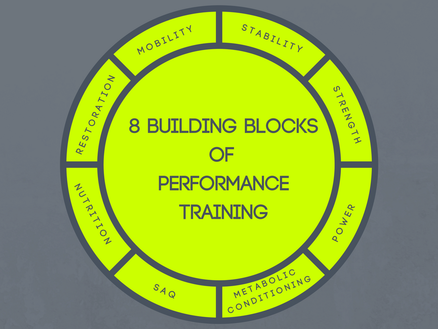Training Elements
This is where the truth gets converted to a plan. Just like a sport coach has their own principles, they also create a game plan with the important elements that they feel effect success. In our planning, it's the same! We start with your unique Blueprint to establish goals, vision, assessment and evaluation. For more information check out the Training Blueprint Page. With your Blueprint in hand, we then move forward to creating your Training Plan. Below are the elements that we use to guide us.
1. 3D MAPS (Property of Gray Institute) is our "the" tool to assess your movement ability, reveal limitations and potential sources of pain.
2. Building Block components of Performance Training guide us in creating our workouts.
3. To help with design and balance we incorporate a strategy called 4Q (Property of IOM)
1. 3D MAPS (Property of Gray Institute) is our "the" tool to assess your movement ability, reveal limitations and potential sources of pain.
2. Building Block components of Performance Training guide us in creating our workouts.
3. To help with design and balance we incorporate a strategy called 4Q (Property of IOM)
1. 3D MAPS Assessment
In order to go where we want to go, we have to know where we are! The best place to get started is the 3D MAPS Video Assessment utilizing Spark Motion Software. 3D MAPS is the best assessment tool to analyze how the human body moves. Like the name says, we evaluate movement mobility and stability in all 3 planes of motion, sagittal, frontal and transverse. In simpler terms, movement that is front to back, side to side and rotational. The video allows us to capture and assess all of the 66 chain reaction movements throughout the entire body! We look at everything from nose to toes because that is how our bodies work!
2. 8 Building Blocks of Performance Training
These are the various qualities in all of our training plans. Depending on your goals, objectives and abilities we incorporate all of these in different capacities to ensure a well round training program. All of these qualities are important for maintaining and developing your health, fitness or sports performance.
|
Mobility - Ability of a joint to move - Increase R.O.M, help flexibility, improve movement Power -The rate of performing work (Power = Work/Time) -Improve explosiveness, movement confidence, speed |
Stability - Motion under control - Create tension, improve timing, rhythm and sequencing of movement Strength -Ability to generate force for a specific function - Maximize the various types of strength for fitness, life & athletics |
|
Speed - Agility - Quickness -Ability to accelerate, decelerate and change direction -Increase athleticism, sport-specific power, prevent injury |
Metabolic Conditioning -Improving our Anaerobic and Aerobic pathways -Great for fat metabolism, heart function, endurance |
|
Nutrition -Providing your body the nutrients it needs for health -Decrease body fat, build muscle, improve energy, fight disease |
Restoration -Return the body to it's normal state -Let the body relax, help regulate stress, aid in the recovery process |
3. 4Q Model
The 4Q Neuro-Mechanical Model (property of Institute of Motion) is a guide to aid in program design. The quadrants divide exercise into loaded versus unloaded training and linear versus movement training. Variability is such an important component in a complete training program and 4Q allows us to prescribe the appropriate amount of the 8 building blocks. Below is a list of exercises for each quadrant.
|
Loaded Linear -Shoulder Press -Squat -Bench Press -Hip Hinge -Olympic Lifts |
Unloaded Linear -Push Up -BW Squat -Kneeling Hip Stretch -Sprints -Pull Up |
Loaded Movement -DB Shuffle to Shift -Bound with Resistance -KB T.G.U -MB Throws -ViPR Halo |
Unloaded Movement -Crawling Push Up -Wide Squat with Arm Twist -Multi-Directional Bound -Rotate Box Jumps -Lunge with Multi-Directional Reach |






